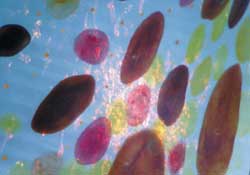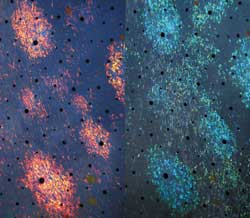Compiled by BioPhotonics staff
Researchers at the Marine Biological Laboratory
(MBL) are preparing to uncover the way in which cephalopods such as squid, octopi
and cuttlefish use light-sensing proteins in their skin to blend into their environment.
What they find may lead to artificial materials that respond to their surroundings.
Camouflage expert Roger Hanlon, who has spent more than three
decades studying the camouflage artistry of cephalopods, will collaborate with materials
scientists and nanotechnologists at Rice University to develop materials that can
mimic cephalopod camouflage.

The image shows chromatophores (large brown, red and yellow structures) and iridophores (pink iridescent splotches) in the skin of the long-finned squid Loligo pealeii. Images courtesy of Lydia Mäthger, Marine Biological Laboratory.
“Our internal name for this project is ‘squid skin,’
but it is really about fundamental research,” said Naomi Halas, an expert
in nano-optics at Rice and principal investigator on the four-year, $6 million grant
Hanlon received from the Office of Naval Research. “Our deliverable is knowledge,
the basic discoveries that will allow us to make materials that are observant, adaptive
and responsive to their environment.”
Hanlon and his MBL colleagues discovered in 2008 that cephalopod
skin contained opsins, the same type of light-sensing proteins that function in
the eyes. The grant will enable the research group to explore a new avenue in vision
research – distributed light sensing throughout the skin, Hanlon said. He
hopes that understanding where and how the visual information is used by the nervous
system will uncover novel neural circuitry.

Iridophores in squid are highly angle dependent. This image depicts
the same iridophore splotches viewed at normal (red) and oblique (blue) angles.
Experiments will be conducted with cephalopods to determine how
opsin molecules receive light and aid the animals’ visual system in adjusting
skin patterns for communication and camouflage. The team of scientists, which includes
researchers from MBL and a marine biologist from the University of Maryland, Baltimore
County, will use a variety of techniques to accomplish its aims.
“This is inherently a multidisciplinary problem,”
Halas said. “What can we, as engineers, learn from the way these animals perceive
light and color?” The team’s engineers will focus on emulating cephalopod
skin using new metamaterials.